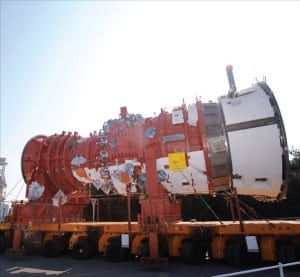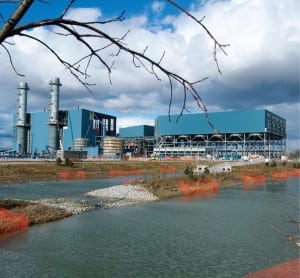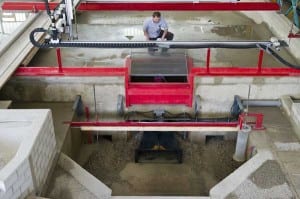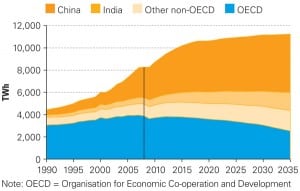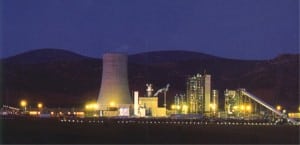Global Monitor
-
Business
POWER Digest (Feb. 2011)
MHI to Continue Pre-Construction Work for North Anna Unit. Mitsubishi Heavy Industries Ltd. (MHI), through Mitsubishi Nuclear Energy Systems Inc., and Dominion subsidiary Virginia Electric and Power Co. on Dec. 27 said they had reached an agreement to continue pre-construction, engineering, and planning work in preparation for a third unit at Dominion’s North Anna Nuclear […]
-
Gas
MHI Prepares to Test J-Series in Japan
Mitsubishi Heavy Industries (MHI) has begun converting a combined-cycle plant in Japan to prepare for verification testing of its long-anticipated J-Series gas turbine in February 2011—a system that the company claims has the most power generation capacity and highest thermal efficiency in the 1,600C turbine inlet temperature class (Figure 3). The work being carried out at the Takasago Machinery Works facility in Hyogo Prefecture (where the company’s G-Series gas turbines were tested) includes installation of the J-Series turbine, and it marks another major milestone in the technology’s development.
-
Gas
TransCanada Opens 683-MW Halton Hills Combined-Cycle Plant
TransCanada Corp. on Oct. 28 officially opened its C$700 million Halton Hills Generating Station. The 683-MW 2 x 1 combined-cycle plant on a greenfield site in Ontario (Figure 5) will operate under a 20-year power purchase agreement with the Ontario Power Authority (OPA). Construction of the peaker plant started in December 2007 and was completed on time and on budget, TransCanada said.
-
Business
POWER Digest (Jan. 2011)
TANE and Shaw to Provide EPC Services for South Texas Expansion. Nuclear Innovation North America LLC (NINA), the nuclear development company jointly owned by NRG Energy and Toshiba Corp., on Nov. 29 announced that it awarded the engineering, procurement, and construction (EPC) contract for South Texas Projects Units 3 and 4 to a restructured EPC […]
-
Hydro
German Researchers Develop Cost-Efficient Small Hydro Plant
Researchers at Germany’s Technische Universitaet Muenchen (TUM) claim to have developed a small-scale hydroelectric power plant that is capable of operating profitably even at modest dam heights while minimizing impact on waterways.
-
Coal
IEA: Global Power Demand to Surge 2.2% Annually Through 2035
Though electricity generation has entered a key period of transition—as investment shifts to low-carbon technologies—world electricity demand is set to grow faster than any other “final form of energy,” the International Energy Agency (IEA) says in its latest annual World Energy Outlook.
-
Hydro
Construction of Tibetan Dam Sets Off Cross-Border Tensions
China in mid-November embarked upon building the first massive hydropower project in Tibet, a 6 x 85-MW plant straddling the middle reaches of the mighty Yarlung Tsangpo River (Figure 2). According to the Hunan Daily, a Chinese state-owned enterprise, Sinohydro began damming the river in Shannan Prefecture, Tibet, on Nov. 8, kicking off the 7.9 billion yuan ($1.2 billion) “run of the river” project that is estimated to generate electricity for the surrounding region by 2014.
-
Wind
Wind Energy Soars Around the World
Denmark put into operation its 12th offshore wind farm this October. The €440 million Rødsand 2 wind farm, a 90-turbine installation with a nameplate capacity of 207 MW, was erected for owner E.ON by Siemens Energy—both German firms—over a mere 122 days. The wind farm joins Rødsand I, a 72-turbine installation that began operating nearby in the Baltic Sea in 2003.
-
Coal
Spain Makes Headway in CCS Efforts
A 14-MW pilot plant built by energy firm ELCOGAS at its 335-MW integrated gasification combined-cycle (IGCC) facility at Puertollano in Spain in September captured its first metric ton of carbon dioxide. Now the company plans to begin tests to procure more technical and economic information about carbon capture and storage (CCS), including how efficient it is to co-produce hydrogen and power with carbon capture processes.
-
Gas
Turkey Opens Record-Breaking Combustion Gas Engine Plant
Turkey, a country that has seen rapid economic growth since the 1980s, largely spurred by a shift in governmental strategy to open up markets and increase private participation, has been actively overhauling its power infrastructure to meet soaring electricity consumption. According to grid operator Turkish Electricity Transmission Co., national consumption increased to 17 billion kWh this September—an 11% increase over the 15.3 billion kWh consumed in September 2009.

